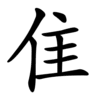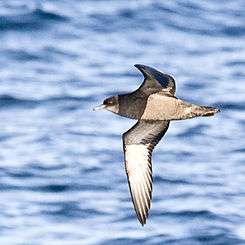隹
| ||||||||
Translingual
| Stroke order | |||
|---|---|---|---|
 | |||

Han character
隹 (radical 172, 隹+0, 8 strokes, cangjie input 人土 (OG) or X人土 (XOG), four-corner 20214/20215, composition ⿰亻⿱亠龶(GHT) or ⿰亻⿻主一(GHT) or ⿰亻⿳丿一龶(JK))
- Kangxi radical #172, ⾫.
Usage notes
This character is used mostly as a character component. Note that, in Japanese and Korean scripts, the dot stroke (㇔) atop the radical (隹) is written from top-right to bottom-left (instead of top-left to bottom-right) as found in the Kangxi dictionary.
Derived characters
References
- KangXi: page 1364, character 5
- Dai Kanwa Jiten: character 41937
- Dae Jaweon: page 1867, character 22
- Hanyu Da Zidian: volume 6, page 4090, character 1
- Unihan data for U+96B9
Chinese
| simp. and trad. |
隹 | |
|---|---|---|
Glyph origin
| Historical forms of the character 隹 | ||||||||||||||||||||||
|---|---|---|---|---|---|---|---|---|---|---|---|---|---|---|---|---|---|---|---|---|---|---|
| Shang | Western Zhou | Shuowen Jiezi (compiled in Han) | Liushutong (compiled in Ming) | |||||||||||||||||||
| Oracle bone script | Bronze inscriptions | Small seal script | Transcribed ancient scripts | |||||||||||||||||||
 |
 |
 |
 | |||||||||||||||||||
| ||||||||||||||||||||||
|
References: Mostly from Richard Sears' Chinese Etymology site (authorisation),
| ||||||||||||||||||||||
| Characters in the same phonetic series (隹) (Zhengzhang, 2003) | |
|---|---|
| Old Chinese | |
| 蜼 | *lus, *rulʔ, *luls |
| 堆 | *tuːl |
| 嵟 | *tuːl |
| 碓 | *tuːls |
| 推 | *tʰuːl, *tʰjul |
| 蓷 | *tʰuːl, *tʰjul |
| 陮 | *duːlʔ |
| 魋 | *duːl |
| 嶊 | *stuːlʔ |
| 崔 | *zluːl, *sʰluːl |
| 猚 | *ŋreːl, *rulʔ |
| 椎 | *dul |
| 顀 | *dul |
| 隹 | *tjul |
| 錐 | *tjul |
| 萑 | *kljul |
| 騅 | *tjul |
| 鵻 | *sɢʷinʔ, *tjul |
| 誰 | *djul |
| 脽 | *djul |
Pictogram (象形) : a short‐tailed bird (e.g. a sparrow). Compare 鳥.
Pronunciation
Japanese
Korean
Hanja
隹 (eum 추 (chu))
- This term needs a translation to English. Please help out and add a translation, then remove the text
{{rfdef}}.
Vietnamese
Han character
隹: Hán Nôm readings: chuy
- This term needs a translation to English. Please help out and add a translation, then remove the text
{{rfdef}}.

















